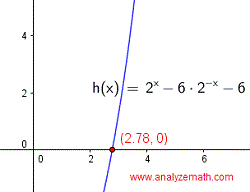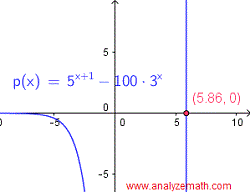
Solution
Note that 27, 9 and 3 may be written as powers of 3 as follows:
27 = 33 , 9 = 32 and 3 = 31
Using the above and also the formula for negative exponent

we rewrite the given equation as follows:
(33)2x (3-2)x - 2 = (32)-x (3-1)2 - x
We now use the formula (xm)n = x m n to rewrite the above equation as follows.
36x 3-2x + 4 = 3-2x 3- 2 + x
Use the formula xm xn = xm + n to rewrite the equation as follows
36x- 2x + 4 = 3- 2x - 2 + x
Simplify the exponents to obtain
34x + 4 = 3- x - 2
We use the fact that an exponential function of the form ax is a one to one function, meaning that if 3m = 3n, then m = n to write an algebraic equation using the above equation:
4x + 4 = - x - 2
Solve the above for x to obtain the solution of the given equation.
5x = - 6 gives the solution x = - 6 / 5 = - 1.2
Below is shown the graph of the left side of the given equation when written with right side equal to zero as follows:

The x intercept is an approximation to the analytical solution found above. Check that they are close in value.
 .
.

Solution
Note that √(16x) = (16x)1/2 = 16(1/2)x and use it to rewrite the given equation as
16(1/2)x = (1/2)x2-1
Note that 1/2 = 2-1 and 16 = 24 and use it to rewrite the above equation as
(24)(1/2)x = (2-1)x2-1
Use the formula (xm)n = x m n to rewrite the above equation as
22x = 2-x2 + 1
We use the fact that an exponential function of the form ax is a one to one function to write.
2x = - x2 + 1
Rewrite in standard form and solve the above quadratic equation.
x2 + 2x - 1 = 0
? = 22 - 4 (1)(-1) = 8
Two solutions: x1 = - 1 - √ 2 ? -2.41 and x2 = - 1 + √ 2 ? 0.41
The graph of the left side of the given equation when written with right side equal to zero as follows:

 .
.
2 x - 6 · 2 - x = 6 ?
Solution
Let u = 2x which also gives 1/u = 2- x and rewrite the equation in terms of u.
u - 6/u = 6
u cannot be zero (because 2x cannot be less than or equal to zero), we therefore multiply all terms of the above equation by u and simplify
u(u - 6/u) = 6 u
u2 - 6 = 6 u
u2 - 6u - 6 = 0
Solve for u
? = (-6)2 - 4(1)(-6) = 60
Two solutions: u1 = 3 + √15 and u2 = 3 - √15
We now solve for x using the above substitution u = 2x.
First equation: 2x = 3 + √15
ln(2x) = ln(3 + √15)
x ln(2) = ln(3 + √15)
Solution: x = ln(3 + √15) / ln 2 ? 2.78
Second equation: 2x = 3 - √15 has no solution because 3 - √15 is less than zero.
Below is shown the graph of the left side of the given equation when written with right side equal to zero as follows: 2 x - 6 · 2 - x - 6 = 0 . The x intercept is an approximation to the solution of the analytical solution found above.
 .
.
5 x+1 = 100 · 3x
Solution
Take the natural logarithm (ln) of both sides
ln (5x + 1) = ln (100 ? 3x )
Use log rules to simplify.
(x + 1) ln 5 = ln 100 + x ln 3
Expand left side and group terms with x.
x ln 5 + ln 5 = ln 100 + x ln 3
x (ln 5 - ln 3) = ln 100 - ln 5
x = (ln 100 - ln 5) / (ln 5 - ln 3) ? 5.86
Below is shown the graph of the left side of the given equation when written with right side equal to zero as follows: 5 x+1 - 100 · 3x = 0 . The x intercept is an approximation to the solution of the analytical solution found above.
 .
.

Solution
Let u = ex which also gives 1/u = e- x and rewrite the equation in u. (u = ex cannot be less than or equal to zero)
(u - 1/u) / 2 = 3
Multiply both sides by 2 and simplify
u - 1 / u = 6
Multiply both sides by u and simplify
u2 - 1 = 6 u
u2 - 6u - 1 = 0
Solve for u
? = (-6)2 - 4(1)(-1) = 40
Two solutions: u1 = 3 + √10 and u2 = 3 - √10
We now solve for x using the above substitution u = ex.
First equation: ex = 3 + √10
ln(ex) = ln(3 + √10)
Solution: x = ln(3 + √10) ? 1.82
Second equation: ex = 3 - √10 has no solution because 3 - √10 is less than zero.
Below is shown the graph of the left side of the given equation when written with right side equal to zero as follows:

 .
.
3 2 - 3x = 4 2x + 1
Solution
Take the natural logarithm (ln) of both sides
ln (32 - 3x) = ln (42x + 1)
Use log rules to simplify.
(2 - 3x) ln 3 = (2x + 1) ln 4
Expand both sides of the equation and group terms with x.
2 ln 3 - 3 x ln 3 = 2 x ln 4 + ln 4
x (-3 ln 3 - 2 ln 4) = ln 4 - 2 ln 3
x = (2 ln 3 - ln 4) / (3 ln 3 + 2 ln 4) ? 0.13
Below is shown the graph of the left side of the given equation when written with right side equal to zero as follows: 3 2 - 3x - 4 2x + 1 = 0. The x intercept is an approximation to the solution of the analytical solution found above.
 .
.
9 x - 3 x + 1 + 2 = 0
Solution
Note that
9x = (32)x = 32 x = (3x)2
Rewrite the given equation using 9x = (3x)2 and also 3x + 1 = 3?3x
(3x)2 - 3?3x + 2 = 0
Let u = 3x and rewrite the equation in u.
u2 - 3 u + 2 = 0
Solve for u by factoring
(u - 2)(u - 1) = 0
Two solutions: u1 = 2 and u2 = 1
We now solve for x using the above substitution u = 3x.
First equation: 3x = 2
ln( 3x) = ln 2
x ln 3 = ln 2
Solution: x = ln 2 / ln 3 ? 0.63
Second equation: 3x = 1 , solution x = 0.
Below is shown the graph of the left side of the given equation. The x intercepts are approximations to the analytical solutions found above.
 .
.